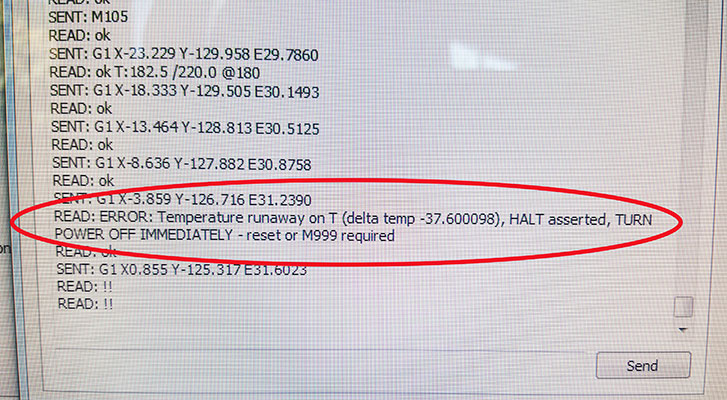I wanted to print something using NGen_FLEX (usually called “Ninjaflex”) rubber filament on my 8-foot-tall Cerberus 3D Gigante printer when I got a “Runaway temperature warning” (right), and the printer shut down.
I checked the graph in Simplify 3D, the combination host and slicer program I was using, and saw the temperature spiking instead of its usual gradual climb.
I shut off the 3D printer, let it cool, and tried it again. Same problem.
I printed the same file with regular PLA and had no problem.
There was only one thing to do …
… call “Superman” Steve Graber, who said it was probably a thermister, or temperature sensor (below, right), or the hotend going bad.
This is all part of having an older 3D printer, and part of increasing the temperature to run other filaments. Unlike standard PLA filament, which heats up at about 190 C, NGen FLEX needs about 220 C to flow right – printing with this rubber filament is really different.
 Steve used an ohm meter to check the thermister. At 88.7, it was fine. Then he began palpating the hotend to see if the problem might be a cracked wire. “This error message usually relates to wiring,” he explained.
Steve used an ohm meter to check the thermister. At 88.7, it was fine. Then he began palpating the hotend to see if the problem might be a cracked wire. “This error message usually relates to wiring,” he explained.
Steve and I continued to troubleshoot, trying to rule out issues. We removed the hotend’s silicone heat sleeve, shot the hotend with the infrared thermometer and tried a meat thermometer with the fan off. The rubber filament was oozing out, but the temperature was not indicating any problem. We also cleaned out the chamber in the hotend, thinking maybe some gunk was causing a problem. No dice.
We shoved some regular PLA through, and it melted right away, suggesting that the 220 temperature was correct.
After a handful of test prints, though, Steve noticed that not enough filament was feeding, so we started playing with that. We marked 100 millimeters, then told Simplify to feed 100 meters, going back and forth until we got that right, fixing a problem we didn’t know we had.
Then we just let the 3D printer run. And it didn’t overheat.
So for now the mystery remains a mystery. Was it a wire that is now conducting better? Or is the hotend or thermister about to go?
As time passes, we are bound to find out – or not. It’s all part of the fun of being in the early days of this crazy technology.

